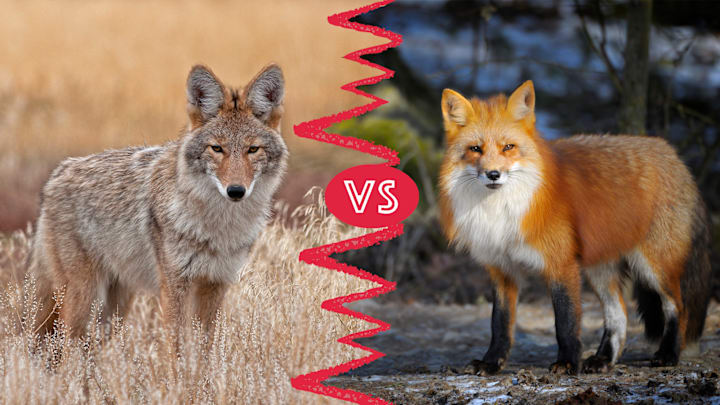Foxes and coyotes share many similarities. They’re both medium-sized canines, both are depicted as crafty tricksters in folklore, and both are menaces to anyone with a chicken coop in their backyard. It may be hard to tell them apart from far away, but there are several major differences distinguishing the two animals.
Animal | Group Type | Color | Range | Size | Diet | Vocalizations | Snout | Most active |
|---|---|---|---|---|---|---|---|---|
Fox | Genus | Varies by species | Every continent except Antarctica | Largest species is 8 to 17 pounds | Omnivorous | Screams | Small and pointed | At night |
Coyote | Species | Mix of tan, black, and gray | North America | 22 to 33 pounds | Omnivorous | Howls | Large and long | At night |
Coyotes and Foxes: How They’re Similar
Known by the scientific name Canis latrans, coyotes have one of the widest ranges of any North American predator. They can be found anywhere from Alaska to the southern tip of Mexico, and they are one of the few species that has benefited from human development. As urbanization drove America’s wolves to the margins, the coyote population exploded to fill the ecological void. Their main prey is small mammals, but they’ve also been known to eat insects, fruit, carrion, and trash, allowing them to survive in cities as well as remote forests and deserts. According to a 2016 study, 96 of the 105 U.S. metro areas that were surveyed were home to coyote populations.
Unlike coyotes, not all foxes belong to the same species. All foxes are members of the genus Vulpes, which encompasses several species including red foxes, arctic foxes, and kit foxes. Foxes also aren’t limited to North America; they can be found on every continent except Antarctica. Many foxes share the coyote’s diverse appetite, surviving on bugs, fruit, and food scraps in addition to fresh and dead meat. This also makes them well-adapted to urban environments. Both species tend to do most of their hunting and scavenging at night.
Visual Differences Between Foxes and Coyotes
With so many overlapping behaviors, the best way to tell coyotes and foxes apart is by sight. Foxes are smaller than coyotes with tiny, pointed snouts. Coyotes have large, long snouts that give them their unique profile. Red foxes—the largest and most common fox species—measure 3 to 4 feet long and weigh between 8 and 17 pounds. Their fluffy tails are long, making up nearly half their length in some cases. As their name suggests, they are also distinguished by their striking red fur, which is most vibrant during the winter months.
Coyotes grow to be about 4 feet long as well, but they have longer legs and stockier bodies. Adults weigh between 22 and 33 pounds. Their coat is a mixture of tan, black, and gray shades that become lighter in the winter.
What Does the Fox—and the Coyote—Say?
You can also identify foxes and coyotes based on the sounds they make. Coyotes make 11 distinct noises, which include dog-like whines, barks, and yelps in addition to their famous howls. You can hear what they sound like below.
Foxes, meanwhile, have 40 distinct vocalizations. They may have the prettier coat of the two predators, but their calls are much less majestic. If you have ever heard a shrill scream or squawk outside your window in the middle of the night, it was likely a fox. Watch the video below to listen to their unique sounds for yourself.
